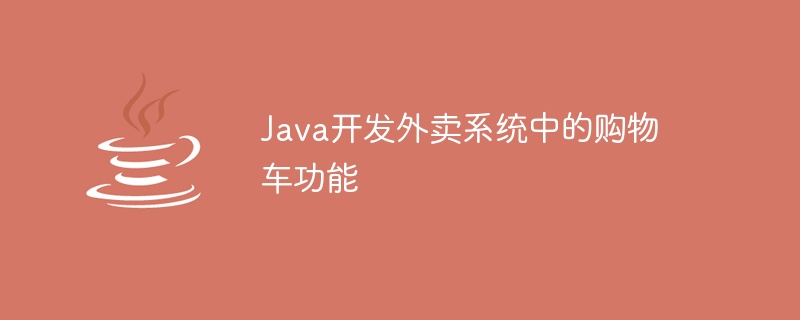Home >Java >javaTutorial >Java develops shopping cart function in takeaway system
Java develops shopping cart function in takeaway system
- WBOYWBOYWBOYWBOYWBOYWBOYWBOYWBOYWBOYWBOYWBOYWBOYWBOriginal
- 2023-11-01 17:40:501021browse

Java develops the shopping cart function in the takeout system
With the rapid development of the takeout industry and the increasing needs of users, the takeout system has become an indispensable part of modern people's lives. A missing part. In the takeout system, the shopping cart function is a very important component. This article will introduce how to use Java to develop the shopping cart function in the takeout system to enable users to add, delete, modify products, and settle transactions.
First of all, the core of the shopping cart function is to record the products selected by the user and the corresponding quantity. In Java, we can use collections (such as List) to store this information. The shopping cart can be abstracted as a class, which contains product information (such as id, name, price, etc.) and quantity. In the shopping cart class, we can provide a series of methods, such as adding products, deleting products, modifying the quantity of products, etc., to implement user operations on the shopping cart.
Next, let us gradually implement the various functions of the shopping cart.
First, we need to define a shopping cart class (ShoppingCart) and declare a collection to store the product information in the shopping cart. In the shopping cart class, we can define the following attributes and methods:
public class ShoppingCart {
private List<CartItem> items; // 商品信息列表
// 构造方法
public ShoppingCart() {
items = new ArrayList<>();
}
// 添加商品到购物车
public void addItem(CartItem item) {
for (CartItem cartItem : items) {
if (cartItem.getId() == item.getId()) {
// 如果商品已存在购物车中,则更新数量
cartItem.setQuantity(cartItem.getQuantity() + item.getQuantity());
return;
}
}
// 如果商品不存在购物车中,则添加到购物车
items.add(item);
}
// 从购物车中删除商品
public void removeItem(int id) {
Iterator<CartItem> iterator = items.iterator();
while (iterator.hasNext()) {
CartItem cartItem = iterator.next();
if (cartItem.getId() == id) {
iterator.remove();
return;
}
}
}
// 修改购物车中商品的数量
public void updateQuantity(int id, int quantity) {
for (CartItem cartItem : items) {
if (cartItem.getId() == id) {
cartItem.setQuantity(quantity);
return;
}
}
}
// 结算购物车
public double calculateTotalPrice() {
double totalPrice = 0.0;
for (CartItem cartItem : items) {
totalPrice += cartItem.getPrice() * cartItem.getQuantity();
}
return totalPrice;
}
}In the shopping cart class, we use List to store product information (CartItem). The CartItem class can contain the following attributes: id (product ID), name (product name), price (product price), quantity (product quantity), etc. The items in the shopping cart are represented by CartItem objects.
Next, in other parts of the takeout system, we can implement the shopping cart function through instances of the shopping cart class. For example, when the user selects an item, we can call the addItem method of the shopping cart instance to add the item to the shopping cart. When the user clicks the checkout button, we can call the calculateTotalPrice method to calculate the total price of the items in the shopping cart.
During the implementation of the shopping cart function, some other details can also be considered. For example, a verification mechanism can be added to ensure that the number of products selected by the user is legal; additional information such as pictures of the products can be added to improve the user experience, etc.
To sum up, the shopping cart is an indispensable function in the takeout system. By using Java collections and object-oriented design ideas, we can easily implement the shopping cart function and provide users with a good shopping experience. The realization of the shopping cart function is not only a technical challenge, but also the understanding and satisfaction of user needs and experience. I believe that with continuous iteration and optimization, the shopping cart function will be more perfect and provide users with a better experience.
The above is the detailed content of Java develops shopping cart function in takeaway system. For more information, please follow other related articles on the PHP Chinese website!
Related articles
See more- PHP shopping cart implementation code example summary
- Implementation of shopping cart function through php+MySQL+jQuery+Ajax
- What are the four commonly used frameworks for java development?
- Use html to create a simple and beautiful shopping cart interface
- Java develops group order management function in takeout system

